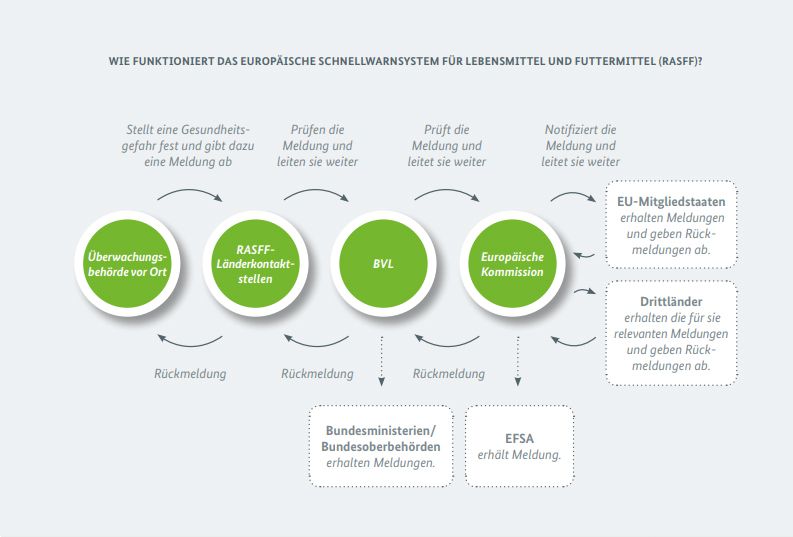
Food safety (or often also called food hygiene) is understood to mean all concepts and measures that ensure that food can be consumed without any adverse health effects and has been produced under hygienically perfect conditions. In order to ensure complete food safety and hygiene, a number of measures and controls are necessary. In this article, we pay particular attention to the legal principles that form the basis for internal hygiene management.
Basics of food safety
The topic of food safety concerns all companies and enterprises in which food is processed. Food safety aims to ensure that food and feed are safe and nutritious, that high standards of animal welfare and plant health are maintained and to provide clear information on the origin, content, labelling and use of food. These objectives can be summarised as follows:
- Maintaining product hygiene
- Prevent contamination and/or residues of unwanted content
- Ensure traceability of product components
Traceability in particular is associated with a documentation effort that should not be underestimated. For the consumer, however, this forms the basis for trustful consumption.
Legal foundations
In the following, we will go into the most important legal principles regarding food safety in order to give you a brief overview of the current legal situation:
EU-Law
- Regulation (EC) No 178/2002 laying down the general principles and requirements of food law, establishing the European Food Safety Authority and laying down procedures in matters of food safety (including the General Food Law, GFL)
- Regulation (EU) No 1169/2011 on the provision of food information to consumers (Food Information Regulation)
- Regulation (EC) No 852/2004 on food hygiene
- Regulation (EC) No 853/2004 laying down specific hygiene rules for food of animal origin
German Law
- German Food and Feed Code
- Regulation implementing provisions of Community food hygiene legislation
- Publication of the justification for the Regulation implementing Community legislation on food hygiene
- Ordinance on hygiene requirements for the production, treatment and marketing of food (Food Hygiene Ordinance – LMHV)
- Regulation on hygiene requirements for the production, handling and placing on the market of certain foodstuffs of animal origin (Food Import Regulation – LMEV)
- Ordinance on Foodstuffs Criminal and Fines (LMRStV)
- General administrative provision on the implementation of official controls on the hygiene of food of animal origin and on the procedure for examining guidelines for good practice (AVV Lebensmittelhygiene – AVV LmH)
- General administrative provision on the collection, evaluation and publication of data on the occurrence of zoonoses and zoonotic agents along the food chain (AVV zoonoses food chain)
The Codex Alimentarius Commission (CAC) establishes international guidelines for food safety. Although the standards of the Codex Alimentarius do not form a binding law, they nevertheless serve as a basis for international trade in food.
Seven basic principles for food production and trade
Uniform food safety standards apply in all EU Member States. The legal framework for food production and trade is based on seven basic principles (Regulation (EC) No 178/2002):
1. Corporate responsibility
- Everyone who trades in or produces food must ensure that his products are flawless. This applies to all those involved in the food production chain.
- Due diligence
- Quality management system HACCP concept
2. Traceability
- Food business operators must not only document where the food is delivered, but also where the food and its raw materials come from.
- The aim is to find the causes quickly and, if necessary, to recall food from the same batch from the trade.
- TRACES (Trade Control and Expert System): electronic system for border control and certification of traded goods
- Lot number (or date)
- Food of animal origin plus oval identification marks
3. Official food monitoring
- Food inspection authorities of the federal states monitor compliance with the requirements
- Control in companies
- Checks are carried out without prior notice
- Checks are carried out at regular intervals
- Check in particular the operational self-checking
- Controls are risk-oriented, i.e. companies with a higher risk are controlled more frequently
- In the event of defects, official food inspection ensures that these are remedied immediately. Measures can be ordered up to the closure of the plant
4. Precautionary principle
- Without knowing the exact risks, authorities can and must take precautionary measures to keep any effects as small as possible. The measures must be proportionate
5. Independent scientific risk assessment
- State investigation offices or the Federal Institute for Risk Assessment examine and assess risks in the food sector.
- European cooperation with EFSA (European Food Safety Authority)
- International cooperation e.g. WHO, FAO (Food and Agriculture Organization of the United Nations)
6. Separation of risk assessment and risk management
- Separation between science and politics / authorities
- Science first prepare an opinion, then a risk manager
- Risk Management: Federal Ministry of Food and Agriculture and Federal Office for Consumer Protection and Food Safety
7. Transparent risk communication
- The public is informed
- By press work of the responsible authorities
- By food recall by the responsible food business operator
- By www.lebensmittelwarnung.de
- By Stiftung Warentest
- By Federation of German Consumer Organisations e.V.
- By the notification center of Nourishment, Agriculture, Consumer protection e.V.
- By the German Nutrition Society e. V.
Official food controls and definitions
The Federal Office for Consumer Protection and Food Safety is the national contact point for the European rapid alert system for food and feed. (Rapid Alert System for Food and Feed, RASFF).

In the course of the RASFF some definitions emerge, which we will explain in more detail at this point in order to better understand the individual requirements.
Food safety is the interaction of scientific evaluation in the laboratory, regulatory risk management (by legislation and inspectors) and food manufacturers.
Controls concern inter alia:
- Food and consumer goods
- General industrial hygiene
- Microbiological impurities
- Violations such as inadmissible irradiation or violation of trade classes
- Deficiencies in hygiene management
- Impurities such as foreign bodies, mycotoxins, pesticide residues, acrylamide
- Labelling and presentation of foodstuffs
- Composition of food
Food monitoring is a measurement programme carried out by the Federal Government and the Länder. The results are used, among other things, to check the maximum levels of undesirable substances. Every food manufacturer must carry out extensive internal controls. Applicable EU standards must be met if someone wants to import food into the EU.
Additives may only be used in quantities which are not objectively harmful to health. In addition, food additives must undergo a strict authorisation procedure, including a comprehensive health assessment. If new findings are available, the assessments shall be re-examined.
Contaminants are substances that are not intentionally added to food but are present in the food as a result of its processing or extraction process. There are contaminants from nature or industrial processes. (Regulation EC No 1881/2006).
Maximum residue content (Regulation EC No. 396/2005) denotes the maximum permissible concentration for the residues of a pesticide active substance. (ATTENTION: organic farming may only use the substances mentioned in the implementing regulations of the EU Organic Basic Regulation for treatment with pesticides)
An important point in RASFF is the HACCP concept. What exactly the HACCP concept is and how you can implement it, we have already explained in a special blog post. Therefore only the most important elements of the HACCP concept:
- Analyzing dangers
- Identify critical control points
- Set limit values
- Introducing a monitoring system
- Implement corrective measures in case of deviations
- Carrying out evaluation measures
- Create documentation
Consequences of food safety violations
The consequences of a violation of food safety can have serious consequences: In the worst case, the food must be taken off the market. In addition, the food business operator may be subject to civil claims for damages arising from defective products (liability for defective products 85/374/EEC). The consequences of a violation of food safety also include:
- Public alerts on affected foodstuffs
- Limit rejections (incl. messages)
- Closures (permanent or temporary)
A good summary of other national and international legislation can also be found on the website of the Federal Ministry of Food and Agriculture.


